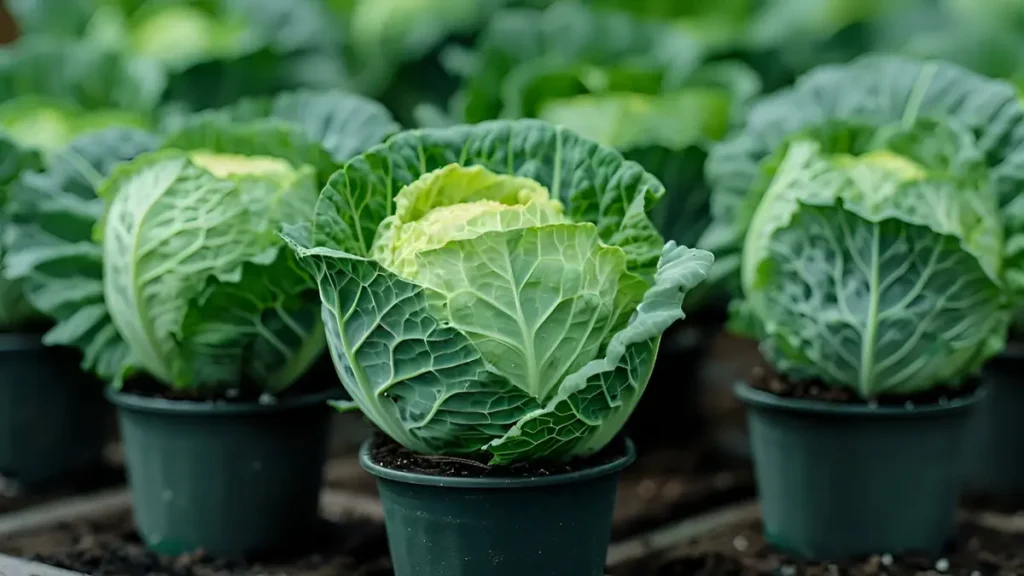Growing cabbage at home in pots can be a rewarding and useful experience. For those with limited outdoor space, container gardening is a flexible alternative that lets you grow crisp, fresh cabbage directly on your patio or balcony.
This is a comprehensive guide to growing cabbage successfully:
Selecting the Ideal Container for Growing Cabbage:
- Select containers that will give the cabbage enough room to develop, preferably with a minimum depth of 12 inches (30 cm) and a comparable width.
- To avoid waterlogging, make sure the containers have drainage holes.
Choosing Types of Cabbage:
- Select small or mini cabbage cultivars, such as “Mini Head,” “Copenhagen Market,” or “Red Express,” that are appropriate for container gardening.
Compost and Manure:
- Make use of premium potting soil that drains easily and is fortified with organic matter. Soils that range from slightly acidic to neutral (pH 6.5 to 7.0) are ideal for cabbage plants. Before planting, mix in either compost or a slow-release balanced fertilizer.
How to plant cabbage seeds for growing cabbage:
- Six to eight weeks before the last anticipated frost, start seeds inside or buy seeds from a nursery.
- In the container, space the seeds or seedlings 12–18 inches (30–45 cm) apart.

Upkeep and Care:
- Make sure the soil is constantly damp but not soggy.
- Water first thing in the morning to let the leaves dry and stave off illnesses.
- The containers should be placed where they will get at least six hours of sunlight each day.
- Apply a water-soluble, balanced fertilizer every two
Diseases and Insects:
- Be wary of common insects that affect growing cabbage, such as slugs, worms, and aphids. Use insecticidal soap, companion planting, or physical obstacles to control them.
- Diseases like clubroot and black rot can affect cabbage. To avoid these problems, rotate your crops and refrain from using overhead irrigation.
Gathering:
- When the heads are hard and the desired size is reached, the cabbage is ready to be gathered. With a sharp knife, cut the head off at the root. It is also possible to gradually harvest outer leaves without impeding the plant’s growth.
Conclusion:
Choosing the proper container size, using well-draining soil, and providing enough sunlight and water are essential for growing cabbage in containers successfully. To protect the cabbage crop, it is imperative to conduct routine inspections for pests and illnesses. Robust growth and abundant harvests are also facilitated by suitable spacing and fertilizer.
Certainly! If you’d like to learn more, please consider following our WhatsApp Channel, Facebook, Instagram, YouTube, Twitter, and Pinterest.
A frequently asked questions:
Q1: For growing cabbage, which hydroponic system works best?
A1: NFT (Nutrient Film Technique) and DWC (Deep Water Culture) systems are commonly used for growing cabbage in hydroponics.
Q2: How do I protect growing cabbage in the winter from frost?
A2: To protect young plants from frost, cover them with cloches or row covers. Mulch should also be applied to the plant bases to help insulate the soil.
Q3: What temperature is ideal for growing cabbage from seed?
A3: When starting cabbage from seed, the recommended temperature range is 60–75°F (15–24°C). For cabbage, this temperature range encourages the best possible seed germination and seedling growth.
Q4: How long does it take for cabbage to grow in pots?
A4: Cabbage grown in pots normally takes between 70 and 120 days to mature, depending on the type. Early-season varieties can be available in as little as 60 days, although bigger or late-season varieties need longer.
Q5: What is the best fertilizer for cabbage?
A5: Nitrogen-rich fertilizers, such as 10-5-5 or 14-14-14, are ideal for cabbage because they encourage vigorous leaf development. Compost or organic matter is also beneficial in providing critical nutrients for proper growth.



